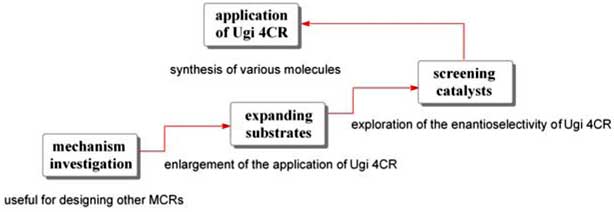Abstract
High efficiency in the organic synthesis makes the multicomponent reaction (MCR) an attractive research field, in which some three-component reactions such as the Strecker (found in 1850), Hantzsch (1882), Biginelli (1891), Mannich (1912), and Passerini (1921) were widely spread, followed by the findings of some four-component reactions such as the Bucherer Bergs and Asinger reactions found in 1929 and 1956, respectively. However, the reaction among ketone, amine, isonitrile, and carboxylic acid to form bisamide found by Ivar K. Ugi in 1959 still takes the most important position in the MCRs because the Ugi four-component reaction (Ugi 4CR) occurs among four organic reagents in methanol or other popular solvents without the aid of any catalysts. Thus, Ugi 4CR represents a selfresembling process among organic reagents and therefore implies the possibility that an organic reaction may involve more than four reagents within one pot operation. Thus, Ugi 4CR can be regarded as the breakthrough in the research of MCRs.
Many published reviews summarize the Ugi 4CR from different viewpoints, but the aim of the presented review on Ugi 4CR together with Passerini three-component reaction (Passerini 3CR) is to introduce a successful mode for the study on MCRs, in which the research on a MCR may involve four aspects including mechanism, substrate, catalyst, and application. The quantum calculation on the energy variation of Ugi 4CR reveals that the addition of isocyanide to imine controls the reaction rate of Ugi 4CR, and imine is generated via the reaction between the amine and ketone at the first step in Ugi 4CR. As a result, the investigation on the substrates of Ugi 4CR focuses on the formation of imine and the resources of carboxylic acid and ketone. Moreover, some catalysts are employed to induce the diastereoisomer ratio because a chiral center is involved in the product of Ugi 4CR. In addition, Lewis acid is used to activate the inert reagents or to drive the further reactions based on Ugi 4CR products.
The application of Ugi 4CR is not the major concern in this review because many previous reviews have focused on this topic. Only some recently published results are documented herein. For example, Ugi 4CR can be used to construct macromolecules with complicated topological structure, to introduce medicinal molecule into nanoparticles, and to synthesize biological-related molecules. Finally, a successful model for the research on MCR can be summarized from the study on Ugi 4CR. Understanding mechanism is the basis for investigating MCR, followed by expanding the suitable substrates and exploring the chiral catalysts. As a result, the MCR can be widely applied to synthesize various molecules.
Keywords: Catalyst, isocyanide, mechanism, multicomponent reaction, passerini reaction, substrate, Ugi reaction.

























